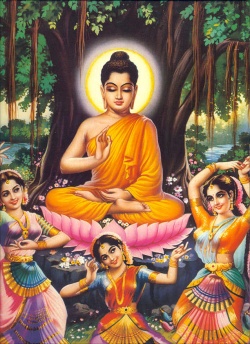The Buddha’s Victory over Mara
Mara in the Buddhist tradition can be best understood as Satan, who always tried to dissuade the Buddha or any one from the righteous path.
He is also called ‘Namuchi’ as none can escape him (Namuci iti Maro); and ‘Vasavatti’ as he rules all (Maro nama Vassavati sabbesam upari vasam vattati).
When Gotama renounced the world and passed through the city gates on his horse Kanthaka, Mara appeared before him and tempted him by the offer to make him a universal monarch in seven days, if he was to change his mind.
Siddhattha, however, did not pay any attention to him.
The origin of the legend of Mara is first noticeable in the Padhana Sutta (See Samyutta Nikaya vs.425-49).
His ten-fold army is Lust; Aversion; Hunger; Thirst; Craving;
Stoth and Torpor; Cowardice; Doubt; Hypocrisy and Stupidity; False Glory; and Conceit.
He has three daughters, Tanha, Arati and Raga representing the three out of the ten forces of Mara’s army.
These daughters were employed to tempt the Buddha after his Enlightenment; and they could assume numerous forms of varying age and charm.
The Buddhavamsa Commentary and Nidanakatha of the Jataka commentary, particularly in the Singhalese versions, unfold a very lively and detailed account of the Mara’s visit to the Buddha just before his Enlightenment, when he was sitting under the Bodhi tree.
Seeing Gotama seated with a firm resolve to become a Buddha, he summoned all his forces to attack Sakyamuni.
The forces extended twelve leagues in front and back; and nine leagues on right and left.
Mara himself with thousand arms riding on his elephant Girimekhala, attacked Gotama.
His followers armed with deadly weapons and assuming various frightening forms joined him in his attack.
The Devas, Nagas, and others who had gathered round Gotama to pay him homage and sing his praises then fled at the sight of the frightening army of Mara.
The Bodhisatta then called the ten paramis, which he had perfected in various births, for his defense.
Each of the ten divisions of Mara’s army was then defeated and routed by one parami.
Eventually, Mara’s army had to flee. Vanquished Mara then hurled his last weapon – the chakkavudha (disc), which stood over the Bodhisatta’s head like a canopy of flowers.
Still Mara tried to dissuade Gotama from the path of the Buddhahood by falsely claiming the Gotama’s seat as his own; and by asking him to prove his right to the seat on which he was sitting.
All the Mara’s followers then testified Mara’s claim by shouting that the seat actually belonged to Mara.
As the Bodhisatta had no other witness to bear testimony on his behalf he asked the Earth to speak for him by touching the ground with his middle finger.
The Earth then roared in response and bore the testimony for the Bodhisatta by thundering, “I stand his witness”.
Thus, the Mara’s defeat was final; and he and his followers had to flee.
The Devas and other celestial beings then besieged him and celebrated his
